[/caption]
Take a good last, long look at the magnificent robot that is Curiosity, because she’s been all buttoned up for her long Martian voyage in search of the ingredients of life. After years of exhaustive work, the most technologically advanced surface robotic rover ever to be sent beyond Earth has been assembled into the flight configuration, a NASA spokesperson informed Universe Today.
The next time Curiosity opens her eyes she will have touched down at the foot of a layered mountain inside the planet’s Gale crater.
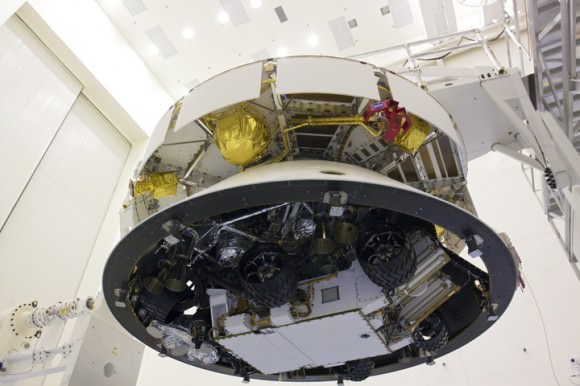
Curiosity – NASA’s next Mars rover – is formally known as the Mars Science Laboratory (or MSL) and has entered the final stages of preflight processing.
After extensive quality assurance testing, Curiosity has been encapsulated for the final time inside the aeroshell that will be her home during the 10 month long interplanetary cruise to Mars. Furthermore, she’s been attached to the cruise stage that will guide her along the path from the home planet to the red planet.
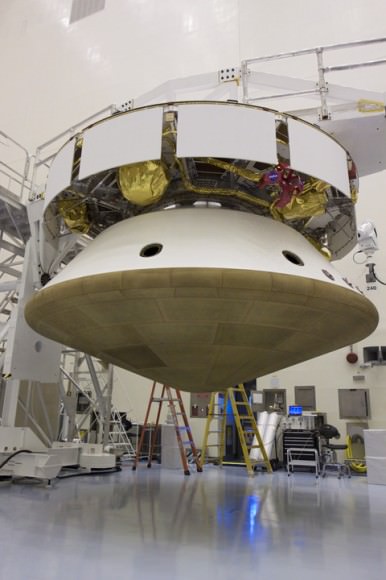
The work to combine all the components into an integrated assembly was carried out inside the clean room facilities of the Payload Hazardous Servicing Facility at NASA’s Kennedy Space Center (KSC) in Florida.
The aeroshell is comprised of the heat shield and back shell.
The job of the aeroshell is to protect Curiosity from the intense heat of several thousand degrees F(C) generated by friction as the delicate assemblage smashes into the Martian atmosphere at about 13,200 MPH (5900 m/s) and plummets some 81 miles during the terrifying seven minute long entry, descent and landing (EDL) on the surface.
See Video animation below
The massive 2000 lb (900 kg) rover is folded up and mated to the back shell powered descent vehicle, known as the PDV or Sky Crane. The spacecraft is designed to steer itself through a series of S-curve maneuvers to slow the spacecraft’s descent through the Martian atmosphere.
In the final moments, the rocket powered Sky crane will lower the robot on tethers and then safely set Curiosity down onto the ground at a precise location inside the chosen landing site astride a layered mountain in Gale Crater believed to contain phyllosilicate clays and hydrated sulfate minerals that formed in liquid water.
The robot is the size of a compact car and measures three meters in length, roughly twice the size of the MER rovers; Spirit and Opportunity. It is equipped with 10 science instruments for a minimum two year expedition across Gale crater.
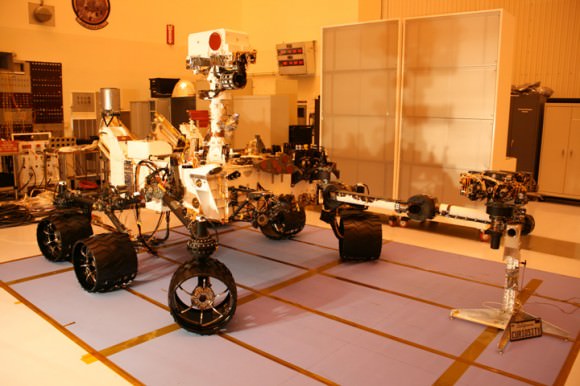
Inside the Clean room at the Payload Hazardous Servicing Facility at the Kennedy Space Center.
The science payload weighs ten times more than any prior Mars rover mission. Curiosity will zap rocks with a laser and deftly maneuver her outstretched robotic arm to retrieve and analyze dozens of Martian soil samples. Credit: Ken Kremer
Curiosity will search for the ingredients of life including water and organic molecules and environmental conditions that could have been hospitable to sustaining Martian microbial life forms if they ever existed in the past or survived to the present through dramatic alterations in Mars climatic and geologic history.
Liftoff of the $2.5 Billion Curiosity rover is slated for Nov. 25 from Cape Canaveral Air Force Station in Florida on a United Launch Alliance Atlas V booster rocket. The launch window to Mars extends until Dec. 18.
This coming week, Curiosity will be encapsulated into the clamshell like payload fairing and the MSL logo will then be applied to the fairing, KSC spokesman George Diller told Universe Today. It will then be hoisted onto the payload transporter and carefully conveyed to Space Launch Complex 41 on Nov. 2, for mating atop the Atlas V rocket.
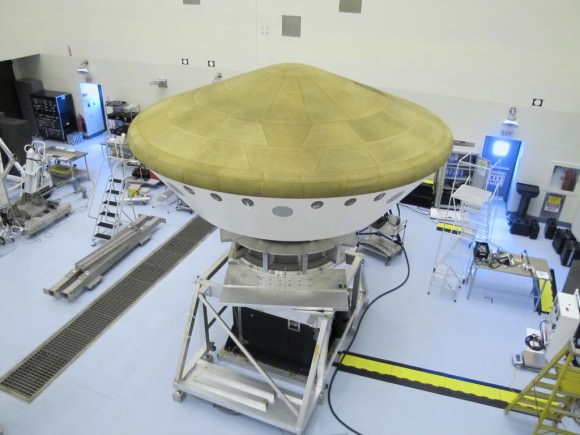
Read Ken’s continuing features about Curiosity starting here:
Assembling Curiosity’s Rocket to Mars
Encapsulating Curiosity for Martian Flight Test
Dramatic New NASA Animation Depicts Next Mars Rover in Action
Read Ken’s features about Russia’s upcoming Phobos-Grunt, Earth’s other 2011 Mars mission here::
Phobos-Grunt and Yinghou-1 Arrive at Baikonur Launch Site to tight Mars Deadline
Phobos-Grunt: The Mission Poster
Daring Russian Sample Return mission to Martian Moon Phobos aims for November Liftoff

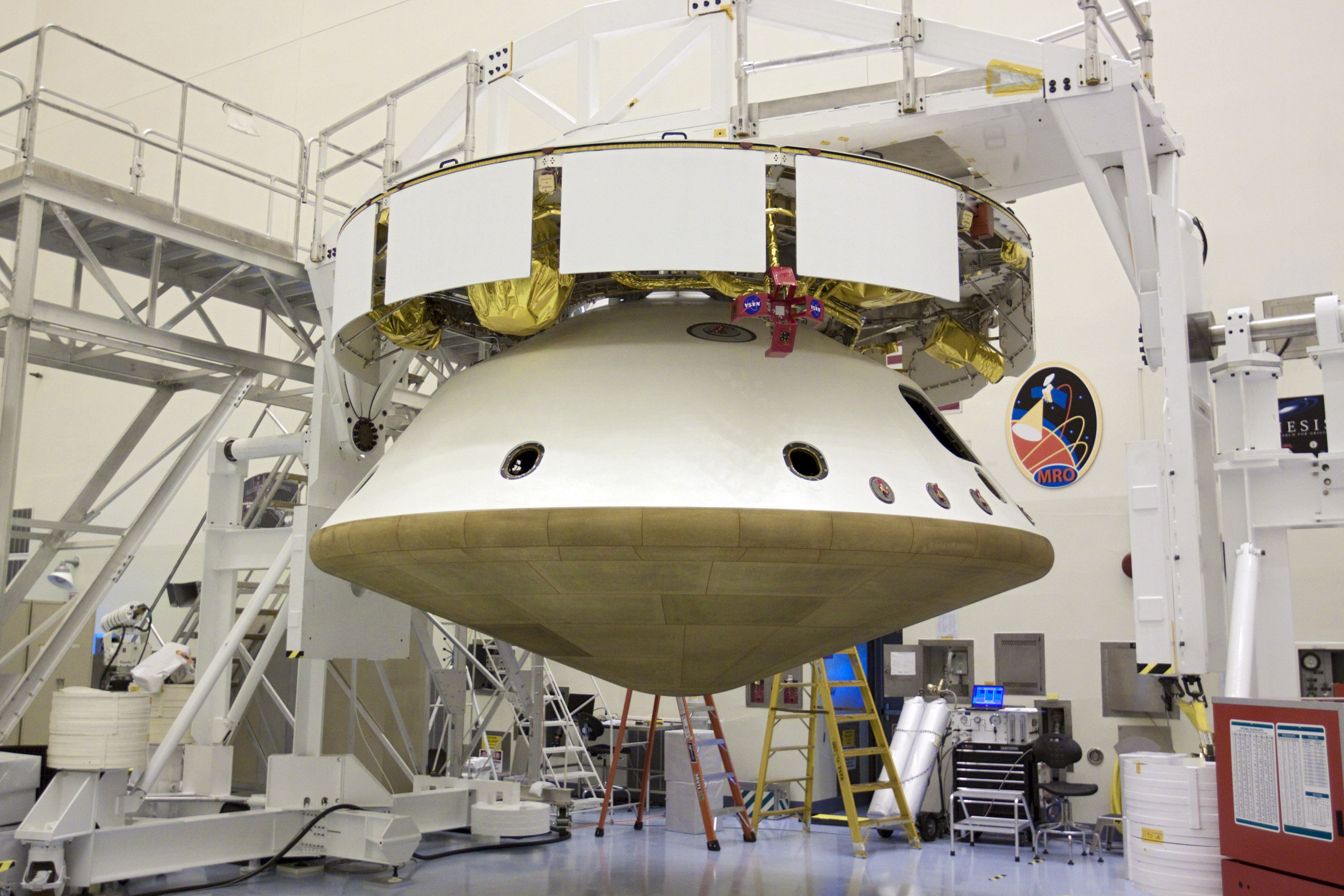
I think one of the weapons on the end of the rotary selector arm should have been a rail gun! Darn NASA cutting the budget, that laser is good against small furry creatures (maybe a baby Ewok) but just won’t have the stopping power needed to kill a Preditor :-/
Oh for God’s sake’s people stop your tedious political squabbling!
The only thing that matters is – if you do find life, DON’T bring it back here and set off a global mass extinction.
Curiosity. My, precious!
But I think the “mass center way up the ceiling” unsecured staple in the last image looks way more scary than the EDL description. If Curiosity survived NASA, it should survive Mars! (O.o)
I didn’t know that, it makes sense and adds to the precision of the new EDL method.
These details is a great part of what makes UT so, well, precious. Keep it up!
Curiosity. My, precious!
But I think the “mass center way up the ceiling” unsecured staple in the last image looks way more scary than the EDL description. If Curiosity survived NASA, it should survive Mars! (O.o)
I didn’t know that, it makes sense and adds to the precision of the new EDL method.
These details is a great part of what makes UT so, well, precious. Keep it up!
Lemmeseehere… launch in Nov/Dec… 10 months travel… arrive in September 2012!
Find LIFE within a month and it’s PUBLICITY for the Obama Reelection Campaign!
HOW CONVENIENT.
Do you expect to find life in a Democrat reelection campaign!? Clinton was the first after Roosevelt.
Why do you think Obama is so exceptionally successful?
hmm? Truman was a democrat. As were Kennedy, Johnson and Carter….
Anyway, not arguing about the Obama comment above. Just wanted to correct the democratic Presidents 🙂
Maybe you have to correct Wikipedia, which was my source?
“Two years later, the re-elected Clinton became the first member of the Democratic Party since Franklin D. Roosevelt to win a second full term as president.”
I checked Truman, and indeed he won a 2nd term, he just didn’t have to win the first as Roosevelt died. The re-election as “first election” is still going on earlier record, so I think Wikipedia is a bit misleading here.
Thanks for setting the record straight!
Wikipedia is correct; it says (my emphasis): “Two years later, the re-elected Clinton became the first member of the Democratic Party since Franklin D. Roosevelt to win a second full term as president.”
Truman just wasn’t initially voted in as president; as you’ve noted, he succeeded to the presidency after President Roosevelt kicked the bucket less than three months after being re-elected.
P.S. Now you see how I spot typographical/grammatical errors – I read carefully!
I didn’t say that they were incorrect, I said they were misleading and even described how I was mislead. Illogically as it may seem, that can be fixed by a correction. (“something offered or substituted for an error; an improvement.”)
… and now I could go on to say something about, um, reading. =D
According to the Oxford Dictionary, the term misleading means “giving the wrong idea or impression”; therefore, you were implying that Wikipedia was incorrect.
Actually, I didn’t realise we were talking about two term democratic presidents! So, maybe its my bad for starting this minor discussion!
Umm–you do understand, don’t you, that launch windows are determined by the relative position of Earth and Mars? If not, do some reading about Hohmann transfer orbits.
Unless, of course, you’re suggesting that the laws of orbital mechanics are subject to political influence.
I doubt Curiosity will “find life.” This mission may find some organic molecules or precursors for life. There is only one apparent way to search for life on Mars. This is to land a robotic molecular biological lab bench on Mars. This is combined with a rover that has a fairly serious drilling rig. The landing site is chosen near a crater with these recently found water gullies that spill from them. The drilling then penetrates into what might be a liquid layer and samples taken for bio-analysis. The rover does not travel far from the lab bench, but rather makes drilling searches at a various points along the crater rim.
The lab bench must then contain systems for attempting to grow Martian life, a PCR system with an electrophoresis system to make DNA southern blots to sequence possible DNA and so forth. If the money is available samples might be bundled up and sent back to Earth in a return vehicle.
Most missions to Mars so far have been largely geological in their purpose. The search for life will require a mission that is primarily devoted to bio-analysis. This means that future missions to Mars may divorce geological studies from biological ones, with missions dedicated to one or the other.
LC
The reason why Curiosity concentrates on finding organics is to assess previous or current habitability. It may well find life or fossils, or the later orbiters that will do the same from space may.
So I don’t think drilling is the only apparent or unique way to find life. But todays organics, if they exist, are then mostly underground and so is existing life.
The absolutely best way to exclude life would be to send paleontologists to Mars for a couple of decades. Barring that, shallow sampling for fossils (Curiosity or later) or deep sampling (ESA) may be the best option. But then we are relying on dense fossils or life, which is unlikely for (at least now) harsh environment.
I don’t see how biology and geology can be split – the geological context is too valuable to find and understand life or fossils. Viking type experiments was the one exception, and today it is too expensive to make such a strike into the dark.
Finding fossils will be hard. I doubt that if there was ever life on Mars, or is there today, that it ever rose to the evolutionary level beyond stromatalites or bacterial mats. So the hunt might be for something similar to that or microfossils of microbial life. That will be tough to find. There will not likely be “trilobites” on Mars. These searches are likely to remain robotic for the time being. I have a tough time seeing humans on Mars for the foreseeable future.
Life might exist on Mars in the liquid layer above the ice self which covers a good percentage of Mars. Mars is to good extent a dirt covered glacial planet. Remove the regolith that may be a few centimeters to meters thick and you might find biological activity on the ice surface where water can exist in a liquid form.
LC